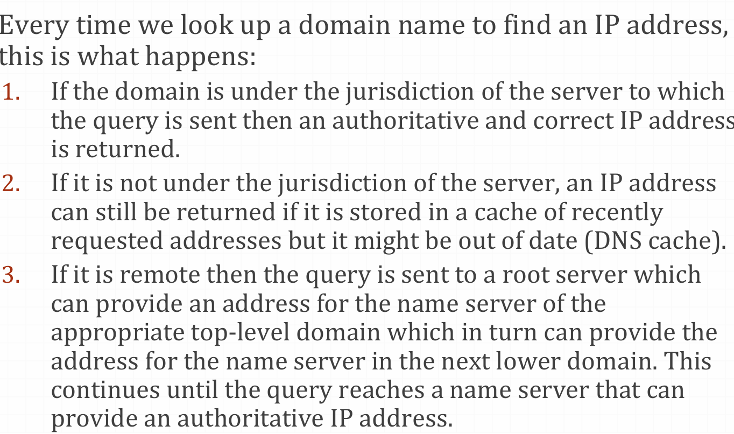-
DNS (Domain name system)
- It is a hierarchical distributed database installed on domain name servers that is responsible for mapping a domain name to an IP address (it is also known as domain name service).
-
URL (Universal Resource Allocator)
- It specifies location of a web page (for example, www.millhill.org.uk)
-
DNS Systems
-
Allocates readable domain names for Internet hosts
-
Provides a system for finding the IP Address for an individual domain name
- Also converts a host name into an IP a computer understands
- This is the same for your phone’s address book (it can only dial numbers, not Pete)
-
Hierarchical distributed database installed on a large number of domain name servers covering the whole of the Internet.
-
DNS name space divided into non overlapping zones, with each one having its own primary name server with the database stored on it.
-
DNS system, URL
-
Secondary servers get info from this primary server
-
250+ top-level domains
- Generic (.gov, .com)
- Or represent countries (.uk, .gr)
-
The domain name is included in a universal resource allocator (URL), which identifies a web page or an email address.
-

-
Cloud computing
-
Storing data online instead of on your own hard drive
- Dropbox, iCloud, Google Drive, Streamable, YouTube, Amazon AWS, Wasabi Hot Storage, Hetzner Storage Boxes
-
Computers and servers that store our date and back it up to ensure there is still a copy if the server breaks down
-
Public Clouds
-
Eg amazon, Microsoft, google, OVH, Hetzner
-
Services and infrastructure provided and shared by all customers
-
Massive amounts of available space – easily scalable
-
Give access to IaaS and SaaS
- Infrastructure as a Service (IaaS) – a virtualised infrastructure
- providing processing power and storage
- Software as a Service (SaaS) – specialised software programs that
- are easy to implement and use
- Infrastructure as a Service (IaaS) – a virtualised infrastructure
-
Advantages: versatility; pay as you go structure to get more capacity on demand
-
Disadvantages: infrastructure and OS controlled solely by cloud provider
-
Private Clouds
- Usually behind a firewall and used by one organisation
- Same as public in that authorised users can access, use and share data from anywhere but no one else can
- Advantages: security, control
- Disadvantages: expensive (company is responsible for software and infrastructure), not as scalable
-
Cloud computing drawbacks
- Worry about security – not “in charge” of storage
- Privacy – usernames, passwords, authentications methods needed
- Who owns the data?
- No Internet = no data
-
Cloud computing benefits
- Access data and files anywhere any time
- Reduced hardware costs
- Don’t need for physical space to store servers (servers will be at cloud company’s site)
-